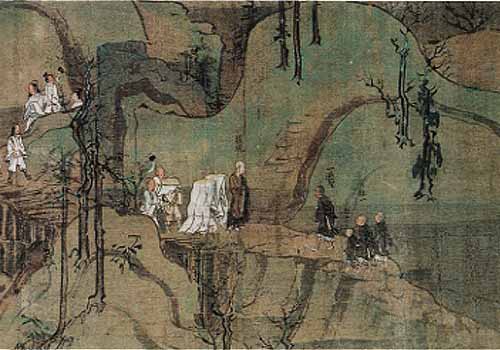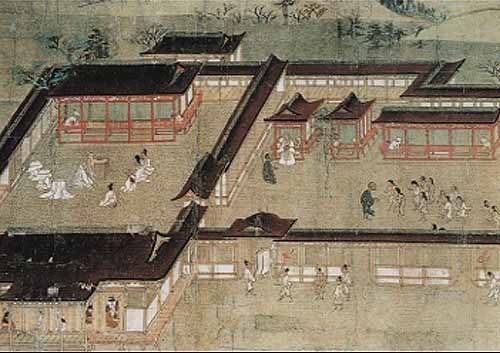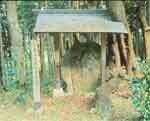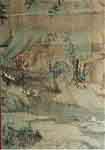
The Story of Kumano -
The Story of "Ippen Shonin"
(A founder of Jishu sect of Buddhism)

The Story of Kumano -
The Story of "Ippen Shonin"
(A founder of Jishu sect of Buddhism)
 Ippen Shonin
was born into the family of the powerful Kouno Suigun
(navy) in Iyo (Ehime Prefecture). He lost his mother and
subsequently became a monk at the age of 10, following his
father's orders. Ippen Shonin's family name was Ochi. He
was born in 1239, the son of Shichiro Michihiro, and
grandson of Kouno Shiro Michinobu. He headed for Dazaifu
for his training at the age of 15. This photo shows the
time when he is just leaving his home with a monk called
Zennyu. The people seeing him off are his father and
other members of his family.
Ippen Shonin
was born into the family of the powerful Kouno Suigun
(navy) in Iyo (Ehime Prefecture). He lost his mother and
subsequently became a monk at the age of 10, following his
father's orders. Ippen Shonin's family name was Ochi. He
was born in 1239, the son of Shichiro Michihiro, and
grandson of Kouno Shiro Michinobu. He headed for Dazaifu
for his training at the age of 15. This photo shows the
time when he is just leaving his home with a monk called
Zennyu. The people seeing him off are his father and
other members of his family.  Ippen
Shonin, after finishing his sermons at Tennoji, followed
the Kumano Kaido High Road to the south and climbed Mt.
Koya to visit the mausoleum of Kobo Daishi. After
climbing up through a forest of stupas you will find an
opening where the mausoleum of Kobo Daishi can be found.
The photo shows Ippen Shonin praying there.
Ippen
Shonin, after finishing his sermons at Tennoji, followed
the Kumano Kaido High Road to the south and climbed Mt.
Koya to visit the mausoleum of Kobo Daishi. After
climbing up through a forest of stupas you will find an
opening where the mausoleum of Kobo Daishi can be found.
The photo shows Ippen Shonin praying there.  After
visiting Mt. Koya, Ippen Shonin went farther down south
towards Kumano. In the mountains of Kumano on the
Nakaheji Route, he encountered Kumano Gongen in the
disguise of a monk. Without knowing that he was Kumano
Gongen, Ippen Shonin chanted Nenbutsu faithfully and
tried to give a talisman to this old monk. But the old
monk refused to receive it saying he could not feel the
depth of Ippen Shonin's faith.
After
visiting Mt. Koya, Ippen Shonin went farther down south
towards Kumano. In the mountains of Kumano on the
Nakaheji Route, he encountered Kumano Gongen in the
disguise of a monk. Without knowing that he was Kumano
Gongen, Ippen Shonin chanted Nenbutsu faithfully and
tried to give a talisman to this old monk. But the old
monk refused to receive it saying he could not feel the
depth of Ippen Shonin's faith.  Ippen
Shonin, after the talisman of his faith was refused, then
visited Kumano Hongu Grand Shrine with a very troubled
mind. There he received a revelation from the Kumano
Gongen. As Ippen Shonin was praying in front of
'Shojoden', the main building on the right, the Kumano
Gongen appeared saying, 'Salvation of all human beings
resides in believing in Amidabutsu. You should give over
your talisman regardless of how faithful or faithless,
pure or impure are the people you meet.' When he came to
himself he found himself surrounded by children who all
wanted his talisman.
Ippen
Shonin, after the talisman of his faith was refused, then
visited Kumano Hongu Grand Shrine with a very troubled
mind. There he received a revelation from the Kumano
Gongen. As Ippen Shonin was praying in front of
'Shojoden', the main building on the right, the Kumano
Gongen appeared saying, 'Salvation of all human beings
resides in believing in Amidabutsu. You should give over
your talisman regardless of how faithful or faithless,
pure or impure are the people you meet.' When he came to
himself he found himself surrounded by children who all
wanted his talisman.  Ippen Shonin,
the founder of the Jishu sect is believed to have
encountered the Kumano Gongen at Kumano Hongu Shrine and
thereby became enlightened. This shows the close relation
of Kumano Gongen of Shinto and Amidanyorai of Buddhism in
the 'Era of Buddhist/Shinto Unification'. Given this
close relationship it was natural for a Buddhist monk to
become enlightened in Kumano. The stone monument for
Ippen Shonin is not the only one honouring a Buddhist in
Kumano. Due to the hand of Tokuhon Shonin, an 18th
century monk of the Jodo sect of Buddhism, other Buddhist
monuments remain in various parts of Kumano.
Ippen Shonin,
the founder of the Jishu sect is believed to have
encountered the Kumano Gongen at Kumano Hongu Shrine and
thereby became enlightened. This shows the close relation
of Kumano Gongen of Shinto and Amidanyorai of Buddhism in
the 'Era of Buddhist/Shinto Unification'. Given this
close relationship it was natural for a Buddhist monk to
become enlightened in Kumano. The stone monument for
Ippen Shonin is not the only one honouring a Buddhist in
Kumano. Due to the hand of Tokuhon Shonin, an 18th
century monk of the Jodo sect of Buddhism, other Buddhist
monuments remain in various parts of Kumano.  The photo
here shows Ippen Shonin and his party going down the
rapids of Kumano River in a river boat from Kumano Hongu
Grand Shrine. Ippen went down the rapids with confidence
in his Nenbutsu after receiving his revelation from the
Kumano Gongen. Today, Kumano River is gentle and tame due
to a newly built dam upstream, but it used to be a rapid
river with a much greater volume of water flowing out to
sea. Ippen Shonin and his party boarded a boat after
visiting Hongu and went down the river like an arrow
navigating many sharp bends and following the river past
steep cliffs and over rushing rapids. The river becomes
gentler as it comes closer to the river mouth making it
easier to disembark at Shingu.
The photo
here shows Ippen Shonin and his party going down the
rapids of Kumano River in a river boat from Kumano Hongu
Grand Shrine. Ippen went down the rapids with confidence
in his Nenbutsu after receiving his revelation from the
Kumano Gongen. Today, Kumano River is gentle and tame due
to a newly built dam upstream, but it used to be a rapid
river with a much greater volume of water flowing out to
sea. Ippen Shonin and his party boarded a boat after
visiting Hongu and went down the river like an arrow
navigating many sharp bends and following the river past
steep cliffs and over rushing rapids. The river becomes
gentler as it comes closer to the river mouth making it
easier to disembark at Shingu.  Ippen Shonin,
after arriving in Shingu, went to the Kumano Hayatama
Grand Shrine and prayed to the Kumano Gongen. You can
walk from the river bank of Kumano River through the main
gate to Kumano Hayatama Grand Shrine. There is also a
South Gate in the middle. To its left is a large shrine
building where people can pray. Ippen Shonin also prayed
there. To the west of the main building there are Kekku,
Hayatamakyu, Shoseiden, Wakamiya, Chushisha, and
Shimoshisha.
Ippen Shonin,
after arriving in Shingu, went to the Kumano Hayatama
Grand Shrine and prayed to the Kumano Gongen. You can
walk from the river bank of Kumano River through the main
gate to Kumano Hayatama Grand Shrine. There is also a
South Gate in the middle. To its left is a large shrine
building where people can pray. Ippen Shonin also prayed
there. To the west of the main building there are Kekku,
Hayatamakyu, Shoseiden, Wakamiya, Chushisha, and
Shimoshisha.  If you follow the coast from Shingu and to Nachi
and then up Nachi River toward the mountains, you will
come to the Kumano Nachi Grand Shrine with the famous
Nachi Falls as a backdrop. It is said that people could
see into the nature of God by standing near this
waterfall.
If you follow the coast from Shingu and to Nachi
and then up Nachi River toward the mountains, you will
come to the Kumano Nachi Grand Shrine with the famous
Nachi Falls as a backdrop. It is said that people could
see into the nature of God by standing near this
waterfall.  There they would pray for Kannon when they
looked up at the Nachi Falls falling down straight out of
the sky and from between the mountains. The photo shows
Nachi Falls as deified in the Hiryu Shrine and Ippen
Shonin visiting Kumano Nachi Grand Shrine. Going up
Daimonzaka through the gate will bring you to Jinguji
Temple, now called Seigantoji Temple. Ippen Shonin is
shown chanting with his heart and soul in front of
Kechigu next to the temple. After visiting Kumano, he
formed the religious order of Jishu and spread the
Nenbutsu among the people.
There they would pray for Kannon when they
looked up at the Nachi Falls falling down straight out of
the sky and from between the mountains. The photo shows
Nachi Falls as deified in the Hiryu Shrine and Ippen
Shonin visiting Kumano Nachi Grand Shrine. Going up
Daimonzaka through the gate will bring you to Jinguji
Temple, now called Seigantoji Temple. Ippen Shonin is
shown chanting with his heart and soul in front of
Kechigu next to the temple. After visiting Kumano, he
formed the religious order of Jishu and spread the
Nenbutsu among the people.
to the top